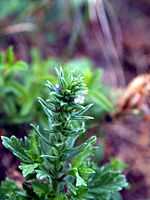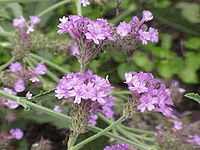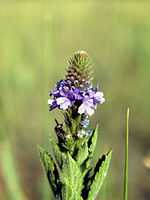Verbena
| Verbena | |
|---|---|
 | |
| Purpletop Vervain, Verbena bonariensis | |
| Scientific classification | |
| Kingdom: | Plantae |
| Phylum: | Angiosperms |
| Class: | Eudicots |
| Order: | Lamiales |
| Family: | Verbenaceae |
| Genus: | Verbena L.[1] |
| Type species | |
| Synonyms | |
Verbena /vərˈbiːnə/,[2] (vervain), is a genus in the family Verbenaceae. It contains about 250 species of annual and perennial herbaceous or semi-woody flowering plants. The majority of the species are native to the Americas and Europe.
Description
The leaves are usually opposite, simple, and in many species hairy, often densely so. The flowers are small, with five petals, and borne in dense spikes. Typically some shade of blue, they may also be white, pink, or purple, especially in cultivars.
The genus can be divided into a diploid North American and a polyploid South American lineage, both with a base chromosome number of seven. The European species is derived from the North American lineage. It seems that verbena as well as the related mock vervains (Glandularia) evolved from the assemblage provisionally treated under the genus name Junellia; both other genera were usually included in the Verbenaceae until the 1990s.[3] Intergeneric chloroplast gene transfer by an undetermined mechanism – though probably not hybridization – has occurred at least twice from vervains to Glandularia, between the ancestors of the present-day South American lineages and once more recently, between V. orcuttiana or V. hastata and G. bipinnatifida. In addition, several species of verbena are of natural hybrid origin; the well-known garden vervain has an entirely muddy history. The relationships of this close-knit group are therefore hard to resolve with standard methods of computational phylogenetics.[4]
Cultivation

Some species, hybrids and cultivars of verbena are used as ornamental plants. They are drought-resistant, tolerating full to partial sun, and enjoy well-drained, average soils. Plants are usually grown from seed. Some species and hybrids are not hardy and are treated as half-hardy annuals in bedding schemes.[5]
They are valued in butterfly gardening in suitable climates, attracting Lepidoptera such as the Hummingbird hawk-moth, Chocolate albatross, or the Pipevine swallowtail, and also hummingbirds, especially V. officinalis, which is also grown as a honey plant.
The hybrid cultivars 'Silver Anne'[6] and 'Sissinghurst'[7] have gained the Royal Horticultural Society's Award of Garden Merit.
Pests and diseases
For some verbena pathogens, see List of verbena diseases. Cultivated verbenas are sometimes parasitized by Sweet potato whitefly (Bemisia tabaci) and spread this pest to other crops.
Other uses
Verbena has longstanding use in herbalism and folk medicine, usually as a tisane. Nicholas Culpeper's 1652 The English Physitian discusses folk uses. Among other effects, it may act as a galactagogue (promotes lactation) and possibly sex steroid analogue. The plants are also sometimes used as abortifacient. Verbena has been listed as one of the 38 plants used to prepare Bach flower remedies,[8] a kind of alternative medicine promoted for its effect on health. However according to Cancer Research UK, "there is no scientific evidence to prove that flower remedies can control, cure or prevent any type of disease, including cancer".[9]
The essential oil of various species - mainly common vervain - is traded as Spanish verbena oil. Considered inferior to oil of Lemon verbena in perfumery, it is of some commercial importance for herbalism and it seems to be a promising source of medical compounds. Verveine, the famous green liqueur from the region of Le Puy-en-Velay (France) is flavored with these vervains.[citation needed]
Verbena in culture
- See also Verbena (disambiguation)

Verbena has long been associated with divine and other supernatural forces. It was called "tears of Isis" in ancient Egypt, and later on "Juno's tears". In ancient Greece it was dedicated to Eos Erigineia. In the early Christian era, folk legend stated that V. officinalis was used to staunch Jesus' wounds after his removal from the cross. It was consequently called "holy herb" or (e.g. in Wales) "Devil's bane".[citation needed]
Vervain flowers are engraved on cimaruta, Italian anti-stregheria charms.[citation needed] In the 1870 The History and Practice of Magic by "Paul Christian" (Jean Baptiste Pitois) it is employed in the preparation of a mandragora charm.[10] The book also describes its antiseptic capabilities (p. 336), and use as a protection against spells (pp. 339, 414).[11]
While common vervain is not native to North America, it has been introduced there and for example the Pawnee have adopted it as an entheogen enhancer and in oneiromancy (dream divination), much as Calea zacatechichi is used in Mexico.
The generic name is the Latin term for a plant sacred to the ancient Romans.[12][13] Pliny the Elder describes verbena presented on Jupiter altars; it is not entirely clear if this referred to a verbena rather than the general term for prime sacrificial herbs.
The common names of verbena in many Central and Eastern European languages often associate it with iron. These include for example the Dutch IJzerhard ("iron-hardener"), Danish Læge-Jernurt ("medical ironwort"), German Echtes Eisenkraut ("true ironherb"), Slovak Železník lekársky ("medical ironherb"), and Hungarian vasfű ("iron grass"). An indeterminate vervain is among the plants on the eighth panel of the New World Tapestry (Expedition to Cape Cod).[citation needed]
In the William Faulkner short story An Odor of Verbena, verbena is used symbolically and described as "the only scent that can be smelled above the scent of horses and courage", similar to the symbolic use of honeysuckle in The Sound and the Fury.[citation needed]
William Carew Hazlitt's Faiths and Folklore (1905) quotes John Aubrey's Miscellanies (1721), to wit:"Vervain and Dill / Hinder witches from their will."[14][15]
In the series of young adult novels The Vampire Diaries, author L. J. Smith uses vervain to protect humans from vampires,[16] in an extension of vervain's fabled magic-suppression powers against witches. In The Struggle, Volume II, the vampire Stefan instructs the human Elena that vervain can "protect you against bewitchment, and it can keep your mind clear if a vampire or another supernatural that is using Powers against you."[17] He tells her how it is prepared and used, "Once I've extracted the oil from the seeds, you can rub it into your skin, or add it to a bath. And you can make the dried leaves into a sachet and carry it with you, or put it under your pillow at night", but gives her an unprepared sprig for protection in the meantime.[18]
In the 1977 novel Aunt Julia and the Scriptwriter by Nobel Prize winner Mario Vargas Llosa, one of the major characters, Pedro Camacho, constantly drinks "verbena-and-mint tea" instead of coffee. The character, a writer of radio soap operas, claims that it "clears the synapses."[19]
In her 1933 thriller "Sweet Danger", Margery Allingham's hero Albert Campion describes vervain as one of the more common preparations for human sacrifice.[citation needed]
Selected species
- See also Aloysia, Glandularia and Junellia for species formerly placed here.
- Verbena alata Cham.
- Verbena andalgalensis Moldenke
- Verbena atacamensis Reiche
- Verbena australis Moldenke
- Verbena balansae Briq.
- Verbena bangiana Moldenke
- Verbena berterii (Meisn.) Schauer
- Verbena berterii f. albiflora Moldenke
- Verbena berterii f. berterii
- Verbena bonariensis L. – Purpletop Vervain, Clustertop Vervain, Tall Verbena, Pretty Verbena, South American Vervain
- Verbena bracteata Lag. & Rodr. – Large-bracted Vervain
- Verbena brasiliensis – Brazilian Verbena, Brazilian Vervain
- Verbena californica – California Vervain, Red Hills Vervain
- Verbena canescens Kunth - Gray Vervain
- Verbena caniuensis Moldenke
- Verbena carnea Medik.
- Verbena carolina L. - Carolina Vervain
- Verbena carollata Briq.
- Verbena catamarcensis Moldenke
- Verbena chacensis Moldenke
- Verbena clavata Ruiz & Pav.
- Verbena cloverae Moldenke - Clover's Vervain
- Verbena cochabambensis Moldenke
- Verbena concepcionis Moldenke
- Verbena cumingii Moldenke
- Verbena cuneifolia Ruiz & Pav.
- Verbena × deamii
- Verbena delicatula Mart. & Zucc.
- Verbena demissa
- Verbena ehrenbergiana Schauer - Ehrenberg's Vervain
- Verbena × engelmannii
- Verbena ephedroides Cham.
- Verbena ephedroides var. entreriensis Tronc.
- Verbena ephedroides var. ephedroides
- Verbena fasciculata Benth.
- Verbena ferreyrae Moldenke
- Verbena filicaulis Schauer
- Verbena gentryi Moldenke
- Verbena glabrata Kunth
- Verbena glutinosa Kuntze
- Verbena goyazensis Moldenke
- Verbena gracilescens (Cham.) Herter
- Verbena gracilis Desf. - Fort Huachuca Vervain
- Verbena grisea B.L.Rob. & Greenm.
- Verbena halei – Texas Vervain Small Munir (sometimes included in V. officinalis) Texas Vervain
- Verbena hastata – Swamp Verbena, Blue Vervain
- Verbena hayekii Moldenke
- Verbena hintonii Moldenke
- Verbena hirta Spreng.
- Verbena hispida Ruiz & Pav.
- Verbena imbricata Wooton & Standl.
- Verbena inamoena Briq.
- Verbena intermedia Gillies & Hook.
- Verbena intermedia f. albiflora Moldenke
- Verbena intermedia f. intermedia
- Verbena intermedia var. intermedia
- Verbena intermedia var. lanuginosa Moldenke
- Verbena johnstonii (Moldenke) G.L.Nesom
- Verbena kuhlmannii Moldenke
- Verbena landbeckii Phil.
- Verbena lasiostachys Link - Western Vervain
- Verbena lindbergi Moldenke
- Verbena lindmanii Briq.
- Verbena litoralis Kunth - Seashore Vervain
- Verbena lobata Vell.
- Verbena longifolia M.Martens & Galeotti
- Verbena lucanensis Moldenke
- Verbena macdougalii A.Heller - MacDougal Vervain
- Verbena macrodonta L.M.Perry
- Verbena malmii Moldenke
- Verbena menthifolia Benth. - Mint Vervain
- Verbena minutiflora Briq.
- Verbena montevidensis Spreng. - Uruguayan Verbena
- Verbena monticola Moldenke
- Verbena multiglandulosa Moldenke
- Verbena neomexicana (A.Gray) Small - Hillside Vervain
- Verbena neomexicana var. hirtella L.M.Perry
- Verbena neomexicana var. neomexicana
- Verbena neomexicana var. xylopoda L.M.Perry
- Verbena nivea Moldenke
- Verbena occulta Moldenke
- Verbena officinalis – Common Vervain, Simpler's Joy, Holy Herb, Mosquito plant, Wild hyssop, Herb of the Cross (Type species)
- Verbena orcuttiana L.M.Perry
- Verbena ovata Cham.
- Verbena paraguariensis Moldenke
- Verbena paranensis Moldenke
- Verbena parvula Hayek
- Verbena paulensis Moldenke
- Verbena paulsenii Phil.
- Verbena pedicellata Moldenke
- Verbena perennis Wooton - Pinleaf Vervain
- Verbena × perriana
- Verbena pinetorum Moldenke - Chihuanhuan Vervain
- Verbena plicata Greene - Fanleaf Vervain
- Verbena polycephala Turcz.
- Verbena porrigens Phil.
- Verbena pseudojuncea Gay
- Verbena ramboi Moldenke
- Verbena ramulosa Phil.
- Verbena recta Kunth
- Verbena rectiloba Moldenke
- Verbena regnelliana Moldenke
- Verbena reineckii Moldenke
- Verbena reitzii Moldenke
- Verbena ribifolia Walp.
- Verbena rigida Spreng. - Tuberous Vervain
- Verbena rigida var. obovata (Hayek) Moldenke
- Verbena rigida var. rigida
- Verbena riparia Raf. ex Small & A.Heller - Riverbank Vervain
- Verbena robusta Greene
- Verbena runyonii Moldenke - Rio Grande Vervain
- Verbena russellii Moldenke
- Verbena × rydbergii
- Verbena scabra Vahl - Sandpaper Vervain
- Verbena scabrella Sessé & Moc.
- Verbena sedula Moldenke
- Verbena simplex Lehm. – Narrow-leaved Vervain
- Verbena spartioides Turcz.
- Verbena speciosa
- Verbena sphaerocarpa L.M.Perry
- Verbena storeoclada Briq.
- Verbena stricta Vent. – Hoary Vervain
- Verbena strigosa Cham.
- Verbena subuligera Greene
- Verbena supina L. - Supine Vervain
- Verbena swiftiana Moldenke
- Verbena tecticaulis Tronc.
- Verbena tessmannii Moldenke
- Verbena teucroides
- Verbena thymoides Cham.
- Verbena tomophylla Briq.
- Verbena townsendii Svenson
- Verbena trachea Phil.
- Verbena trifida Kunth
- Verbena triphylla L.
- Verbena triternata Phil.
- Verbena urticifolia – White Vervain
- Verbena valerianoides Kunth
- Verbena variabilis Moldenke
- Verbena villifolia Hayek
- Verbena weberbaueri Hayek
- Verbena xutha Lehm. - Gulf Vervain[20]
-
Lemon Verbena, Aloysia citrodora (formerly in Lippia), a close relative of true Verbenas
See also
- Arthur B. Howard
- Other "verbenas"/"vervains" of the family Verbenaceae:
- Lemon Verbena, Aloysia citrodora[Note 1]
- Licorice Verbena, Phyla alba
- Mock verbenas, genus Glandularia
- Pineapple Verbena, Nashia inaguensis
- Shrub verbenas, genus Lantana
- Unrelated flowering plants called "verbenas"/"vervains":
- Sand-verbenas, genus Abronia
- Sweet Verbena-tree or -myrtle, Backhousia citriodora
- Unrelated plants whose scientific names refer to Verbena:
- Crownbeard, the genus Verbesina
- Cordia verbenacea
- Wild Clary, Salvia verbenaca
- Verbena, Alabama - a U.S. city named after the Verbena plant
Notes
- ↑ Lippia citrodora is an obsolete name still often seen.
References
- ↑ 1.0 1.1 "Genus: Verbena L.". Germplasm Resources Information Network. United States Department of Agriculture. 2004-01-29. Retrieved 2011-08-29.
- ↑ Sunset Western Garden Book, 1995:606–607
- ↑ S. M. Botta, S. Martinez & M. E. Mulguta de Romero (1995). "Novedades nomenclaturales en Verbenaceae" [Nomenclatural revisions in Verbenaceae]. Hickenia 2: 127–128.
- ↑ Yao-Wu Yuan & Richard G. Olmstead (2008). "A species-level phylogenetic study of the Verbena complex (Verbenaceae) indicates two independent intergeneric chloroplast transfers". Molecular Phylogenetics and Evolution 48 (1): 23–33. doi:10.1016/j.ympev.2008.04.004.
- ↑ RHS A-Z encyclopedia of garden plants. United Kingdom: Dorling Kindersley. 2008. p. 1136. ISBN 1405332964.
- ↑ "RHS Plant Selector Verbena 'Silver Anne' (G) AGM / RHS Gardening". Apps.rhs.org.uk. Retrieved 2013-05-06.
- ↑ "RHS Plant Selector Verbena 'Sissinghurst' (G) AGM / RHS Gardening". Apps.rhs.org.uk. Retrieved 2013-05-06.
- ↑ D. S. Vohra (1 June 2004). Bach Flower Remedies: A Comprehensive Study. B. Jain Publishers. p. 3. ISBN 978-81-7021-271-3. Retrieved 2 September 2013.
- ↑ "Flower remedies". Cancer Research UK. Retrieved September 2013.
- ↑ Pitois, Christian (1952). The History and Practice of Magic, Volume 2, Forge Press. p. 402.
- ↑ Pitois, (1952) p. 336, 339, 414
- ↑ Quattrocchi, Umberto (2000). CRC World Dictionary of Plant Names. 4 R-Z. Taylor & Francis US. p. 2787. ISBN 978-0-8493-2678-3.
- ↑ Gledhill, D. (2008). The Names of Plants (4 ed.). Cambridge University Press. p. 399. ISBN 978-0-521-86645-3.
- ↑ Hazlitt, William Carew; Brand, John (1905). "Faiths and folklore: a dictionary of national beliefs". citing(550, 569, 611), John Aubrey, Esq.'s Miscellanies (1857), p. 147 2 (New York: Charles Scribner's Sons). p. 611. Retrieved September 15, 2010.
- ↑ Aubrey, John, Esq. (1721). Miscellanies upon the following Subjects.... London: Bettesworth, Battley, Pemberton, Curll. Retrieved September 15, 2010.
- ↑ Sheffield, Rob (April 08, 2010). Love in Vein: The Vampire Diaries. Rolling Stone. Retrieved 2010-09-15.
- ↑ Smith, L. J. (1991). The Struggle (Volume II). Harper Collins. p. 105. ISBN 0-06-102001-X. Retrieved 2010-09-15.
- ↑ Smith (1991), p. 145
- ↑ Vargas LLosa, Mario, Aunt Julia and the Scriptwriter, 1977, MacMillan, p. 242
- ↑ "GRIN Species Records of Verbena". Germplasm Resources Information Network. United States Department of Agriculture. Retrieved 2011-08-29.
External links
| Wikimedia Commons has media related to Verbena. |
| Wikispecies has information related to: Verbena |




